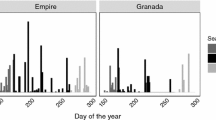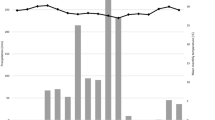Abstract
The relative effects of irradiance and soil water on alley-cropped herbage are poorly understood. Our objective was to determine effects of irrigation on herbage productivity when tall fescue [Lolium arundinaceum (Schreb.) Darbysh.] was grown in two sites, a meadow and a loblolly pine (Pinus taeda L.) alley (620 trees ha−1), near Booneville, Arkansas. Three tall fescue entries were space planted in the meadow and pine alley with or without irrigation. Herbage mass and nutritive value were determined at 8-week intervals for 2 years. Mean daily PAR was 33.9 (2004) and 37.5 mol m−2 d−1 (2005) in the meadow, while the pine alley received 5.6 mol m−2 d−1 (17% of the meadow) in 2004 and 4.3 mol m−2 d−1 (11% of meadow) in 2005. Effect of tall fescue entry tended to be small relative to site and irrigation. Irrigation compensated for evapotranspiration in the meadow, but not in the pine alley when summer rainfall was about normal (2004) or low (2005). Nevertheless, site (PAR) had a greater effect on herbage specific leaf weight, leaf elongation rate, tillers plant−1, mass tiller−1, and total nonstructural carbohydrate concentration than soil water. Irrigation might have had greater impact on herbage productivity if more water had been applied or if canopy cover had been less extreme. Silvicultural practices should be imposed to improve penetration of solar irradiance to the alley crop.









Similar content being viewed by others
References
Allard G, Nelson CJ, Pallardy SG (1991a) Shade effects on growth of tall fescue: I. Leaf anatomy and dry matter partitioning. Crop Sci 31:163–167
Allard G, Nelson CJ, Pallardy SG (1991b) Shade effects on growth of tall fescue: II. Leaf gas exchange characteristics. Crop Sci 31:167–172
Allen RG, Pereira LS, Raes D, Smith M (1998) Crop evapotranspiration, guidelines for computing crop water requirements. FAO irrigation and drainage paper 56. Food and agriculture organization of the United Nations, Rome
Ares A, Brauer D (2005) Aboveground biomass partitioning in loblolly pine silvopastoral stands: spatial configuration and pruning effects. Ecol Manage 219:176–184
Assuero SG, Matthew C, Kemp P, Barker DJ, Mazzanti A (2002) Effects of water deficit on Mediterranean and temperate cultivars of tall fescue. Aust J Agric Res 53:29–40
Beard JB (1973) Turfgrass science and culture. Prentice Hall, Englewood Cliffs, NJ
Belesky DP (2005a) Growth of Dactylis glomerata along a light gradient in the central Appalachian region of the eastern USA: I. Dry matter production and partitioning. Agrofor Syst 65:81–90
Belesky DP (2005b) Growth of Dactylis glomerata along a light gradient in the central Appalachian region of the eastern USA: II. Mechanisms of leaf dry matter production for plants establishing in spring or late summer. Agrofor Syst 65:91–98
Belesky DP, Chatterton NJ, Neel JPS (2006) Dactylis glomerata growing along a light gradient in the central Appalachian region of the eastern USA: III. Nonstructural carbohydrates and nutritive value. Agrofor Syst 67:51–61
Burner DM (2003) Influence of alley crop environment on orchardgrass and tall fescue herbage. Crop Sci 95:1163–1171
Burner DM, Belesky DP (2004) Diurnal effects on nutritive value of alley-cropped orchardgrass herbage. Crop Sci 44:1776–1780
Burner DM, MacKown CT (2005) Herbage nitrogen recovery in a meadow and loblolly pine alley. Crop Sci 45:1817–1825
Burner DM, MacKown CT (2006) Nitrogen effects on herbage nitrogen use and nutritive value in a meadow and loblolly pine alley. Crop Sci 46:1149–1155
Burner DM, Balasko JA, O’Brien PM (1988) Attributes of tall fescue germplasm of diverse geographic origin. Crop Sci 28:459–462
Campbell CD, Atkinson D, Jarvis PG, Newbould P (1994) Effects of nitrogen fertiliser on tree/pasture competition during the establishment phase of a silvopastoral system. Ann Appl Biol 124:83–96
Chirko CP, Gold MA, Nguyen PV, Jiang JP (1996) Influence of direction and distance from trees on wheat yield and photosynthetic photon flux (Q p) in a Paulownia and wheat intercropping system. Ecol Manage 83:171–180
Cui L, Li J, Fan Y, Xu S, Zhang Z (2006) High temperature effects on photosynthesis, PSII functionality and antioxidant activity of two Festuca arundinacea cultivars with different heat susceptibility. Bot Stud 47:61–69
Devkota NR, Wall AJ, Kemp PD, Hodgson J (2001) Relationship between canopy closure and pasture production in deciduous tree based temperate silvopastoral systems. In: Gomide JA, Mattos WRS, Da Silva SC (eds) Proc int grassl conf, 19th, Sao Paulo, Brazil, 11–21 Feb. 2001. Fundacao de Estudios Agrarios “Luiz de Queroz,” Piracicaba, Brazil. pp 652–653
Feldhake CM (2001) Microclimate of a natural pasture under planted Robinia pseudoacacia in central Appalachia, West Virginia. Agrofor Syst 53:297–303
Friday JB, Fownes JH (2002) Competition for light between hedgerows and maize in an alley cropping system in Hawaii, USA. Agrofor Syst 55:125–137
Gautier H, Varlet-Grancher C, Hazard L (1999) Tillering responses to the light environment and to defoliation in populations of perennial ryegrass (Lolium perenne L.) selected for contrasting leaf length. Ann Bot 83:423–429
Hopkins AA, Alison MW (2006) Stand persistence and animal performance for tall fescue endophyte combinations in the south central USA. Agron J 98:1221–1226
Hume DE, Barker DJ (2005) Growth and management of endophytic grasses in pastoral agriculture. In: Roberts CA, West CP, Spiers DE (eds) Neotyphodium in cool-season grasses. Blackwell Publ, Ames, Iowa, pp 201–226
Jackson NA, Wallace JS, Ong CK (2000) Tree pruning as a means of controlling water use in an agroforestry system in Kenya. Ecol Manage 126:133–148
Jose S, Gillespie AR, Seifert JR, Biehle DJ (2000) Defining competition vectors in a temperate alley cropping system in the midwestern USA. 2. Competition for water. Agrofor Syst 48:41–59
Kephart KD, Buxton DR (1993) Forage quality responses of C3 and C4 perennial grasses to shade. Crop Sci 33:831–837
Knowles RL, Horvath GC, Carter MA, Hawke MF (1999) Developing a canopy closure model to predict overstorey/understorey relationships in Pinus radiata silvopastoral systems. Agrofor Syst 43:109–119
Littell RC, Milliken GA, Stroup WW, Wolfinger RD (1996) SAS System for Mixed Models. SAS Institute Inc., Cary, North Carolina
Malinowski DP, Belesky DP, Lewis GC (2005) Abiotic stresses in endophytic grasses. In: Roberts CA, West CP, Spiers DE (eds) Neotyphodium in cool-season grasses. Blackwell Publ, Ames, Iowa, pp 187–199
McNulty SG, Vose JM, Swank WT (1996) Loblolly pine hydrology and productivity across the southern United States. Ecol Manage 86:241–251
National Oceanic and Atmospheric Administration (NOAA) (2002) Climatography of the United States No. 81, Arkansas. NOAA, National Climatic Data Center, Asheville, North Carolina
Omacini M, Chaneton EJ, Ghersa C (2005) A hierarchical framework for understanding the ecosystem consequences of endophyte—grass symbioses. In: Roberts CA, West CP, Spiers DE (eds) Neotyphodium in cool-season grasses. Blackwell Publ, Ames, Iowa, pp 141–162
Pearcy RW (1990) Sunflecks and photosynthesis in plant canopies. Ann Rev Plant Physiol Plant Mol Biol 41:421–453
Popay AJ, Bonos SA (2005) Biotic responses in endophytic grasses. In: Roberts CA, West CP, Spiers DE (eds) Neotyphodium in cool-season grasses. Blackwell Publ, Ames, Iowa, pp 163–185
SAS Institute (2002) SAS/STAT user’s guide. Release 9.1. Windows version 5.1.2600. SAS Inst, Cary, North Carolina
Schultz RP (1997) Loblolly pine. US Dept Agric, For Serv, Agric Hndbk 713. US Govt Print Off, Washington, DC
Snyder RL, Eching S (2003) PMday, Penman-Monteith daily. http://biomet.ucdavis.edu/Evapotranspiration/PMdayXLS/PMday.xls. The Regents of the Univ. California, Davis, California. Cited 25 Feb 2008
Thomas H, James AR (1999) Partitioning of sugars in Lolium perenne (perennial ryegrass) during drought and on rewatering. New Phytol 142:295–305
van der Ploeg RR, Böhm W, Kirkham MB (1999) On the origin of the theory of mineral nutrition of plants and the Law of the Minimum. Soil Sci Soc Am Proc 63:1055–1062
Wherley BG, Gardner DS, Metzger JD (2005) Tall fescue photomorphogenesis as influenced by changes in the spectral composition and light intensity. Crop Sci 45:562–568
Wilman D, Gao Y, Leitch MH (1998) Some differences between eight grasses within the Lolium-Festuca complex when grown in conditions of severe water shortage. Grass Forage Sci 53:57–65
Wilson SP (1998) Competition between grasses and woody plants. In: Cheplick GP (ed) Population biology of grasses. Cambridge Univ. Press, New York, pp 231–254
Acknowledgements
The authors gratefully acknowledge the technical assistance of K. Chapman and J. Whiley (USDA-ARS, Booneville, AR) and J. Ruckle (USDA-ARS, Beaver, WV). Dr. Joe Bouton, The Samuel Roberts Noble Foundation, Ardmore, OK, graciously donated Ky31 E– seed. Dr. Gregory Cheplick (CUNY, Staten Island, NY) and Dr. Matt Sanderson (USDA-ARS, University Park, PA) offered helpful criticisms on an early version of the manuscript. Mention of trade names or commercial products in this article is solely for the purpose of providing specific information and does not imply recommendation or endorsement by the US Department of Agriculture.
Author information
Authors and Affiliations
Corresponding author
Rights and permissions
About this article
Cite this article
Burner, D.M., Belesky, D.P. Relative effects of irrigation and intense shade on productivity of alley-cropped tall fescue herbage. Agroforest Syst 73, 127–139 (2008). https://doi.org/10.1007/s10457-008-9118-5
Received:
Accepted:
Published:
Issue Date:
DOI: https://doi.org/10.1007/s10457-008-9118-5




